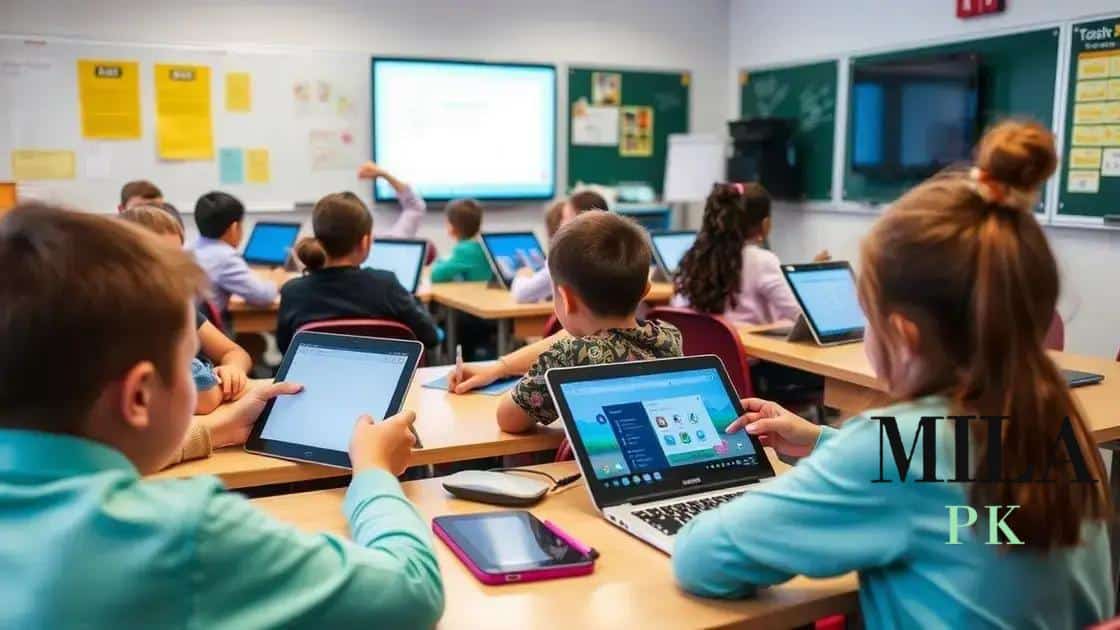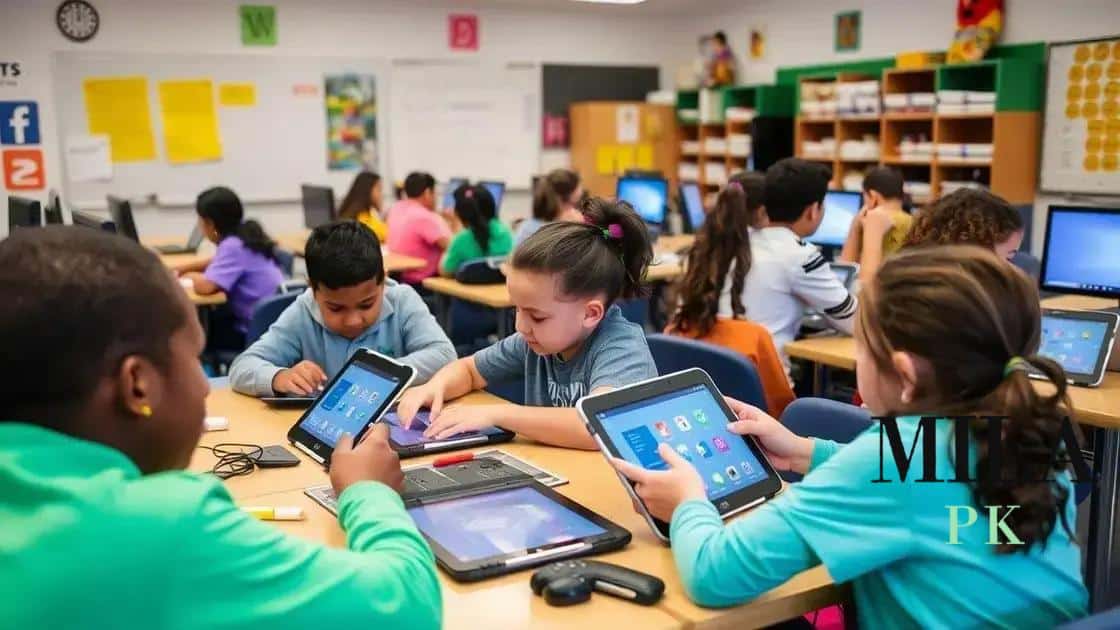Digital learning tools reshape the classroom experience

Digital learning tools reshape the classroom experience by enhancing engagement, personalizing learning, and incorporating technologies like AI, virtual reality, and blended learning approaches to better meet student needs.
Digital learning tools reshape the classroom experience in remarkable ways. Have you ever considered how these technologies can make learning more interactive and engaging? In this article, we’ll dive into the impact and benefits of these innovative tools in education.
Understanding digital learning tools
Understanding digital learning tools is crucial for enhancing the educational landscape. These tools are designed to make learning more engaging and effective. They help students grasp complex concepts and foster collaboration among peers.
What Are Digital Learning Tools?
Digital learning tools encompass a wide range of technologies. They include software, applications, and online platforms that facilitate learning. For example, interactive learning apps can make studying more interactive. Additionally, learning management systems (LMS) allow teachers to track students’ progress easily.
Benefits of Digital Learning Tools
There are several advantages to using digital learning solutions:
- The ability to access materials anytime and anywhere increases flexibility.
- Interactive elements like quizzes can enhance understanding and retention.
- Real-time feedback helps students progress at their own pace.
Furthermore, digital learning tools promote a sense of ownership in students. When learners engage with technology, they often feel more responsible for their education. This engagement can lead to a deeper understanding of the material being studied.
Teachers also benefit from these tools. They can easily incorporate multimedia resources into their lessons, making subjects more appealing. For example, using videos can explain complex topics that are hard to visualize. Moreover, technology can help streamline administrative tasks, allowing educators to focus more on teaching.
Types of Digital Learning Tools
Various types of digital learning tools exist to suit different learning styles:
- Collaborative tools, like Google Docs, enable group work.
- Gamified learning tools engage students through fun challenges.
- Educational software offers practice in specific subjects.
Ultimately, understanding how to utilize these tools effectively can shape a better learning environment. As technology continues to evolve, educators must stay informed about new tools. This can greatly impact their teaching strategies and student success.
Benefits of integrating technology in classrooms

Integrating technology into classrooms offers numerous benefits for both students and teachers. Digital tools make learning more engaging and effective. They can change the way education is delivered and how students interact with their peers and teachers.
Enhanced Engagement
One of the biggest advantages of using technology is the increase in student engagement. Interactive lessons captivate students’ attention. For instance, gamified learning can make lessons fun. When students enjoy learning, they are more likely to participate actively.
Personalized Learning
Technology enables personalized learning. Teachers can tailor lessons to meet individual students’ needs. With adaptive learning programs, each student progresses at their own pace. This approach helps students master concepts before moving on.
- Students can choose topics they find interesting.
- Online quizzes provide immediate feedback.
- Learning management systems allow tracking of student progress easily.
Moreover, technology facilitates peer collaboration. Students can work together on projects using collaborative tools. This builds teamwork skills essential for the future. The flexibility of digital tools encourages diverse learning styles.
The convenience of technology also extends to access to resources. Students can find information quickly via the internet. Multimedia content like videos and interactive simulations provide varied learning experiences. This not only makes lessons more dynamic but also helps with understanding complex topics.
Preparation for the Future
Integrating technology in classrooms also prepares students for future careers. In today’s job market, digital skills are vital. By learning to use various technologies, students are better equipped for the workforce. This exposure fosters skills such as critical thinking and problem-solving.
Furthermore, teachers benefit from technology integration as well. They can easily organize their lessons and reach more students efficiently. Integrating technology can also lighten the administrative load, giving them more time to focus on teaching.
Key features of effective digital learning tools
Key features of effective digital learning tools are essential for enhancing the educational experience. These tools should be user-friendly, engaging, and adaptable to different learning styles. Understanding these features can help educators choose the best resources for their classrooms.
User-Friendly Interface
One crucial characteristic is a simple and intuitive interface. If a tool is difficult to navigate, students may become frustrated. A user-friendly design enables students to focus on learning rather than struggling with technology.
Engagement Features
Effective tools include features that promote engagement. Interactive elements like quizzes, games, and multimedia presentations can capture students’ interest. For example, incorporating videos or animations can make abstract concepts more concrete. This keeps students active and involved throughout the learning process.
- Gamification helps motivate learners.
- Discussion forums enable collaboration.
- Instant feedback mechanisms enhance understanding.
Additionally, adaptability is a vital feature. Good digital learning tools should cater to diverse learning styles. They must offer different types of content such as visuals, text, and audio. This allows every student to engage with the material in a way that suits them best. It fosters a more inclusive learning environment.
Assessment and Tracking
Another important feature is the ability to assess student performance effectively. Digital tools should include tracking systems to monitor progress. This helps teachers identify areas where students may need extra support. For example, formative assessments can provide immediate feedback, allowing for timely intervention.
Furthermore, data analysis tools can offer insights into student engagement and comprehension. Educators can use this data to adjust their teaching strategies accordingly. Effective digital learning tools work as partners in education, helping both students and teachers succeed.
Finally, integration with other systems is essential. Digital learning tools should work seamlessly with existing classroom technologies. This ensures a smooth transition and encourages collaboration among different platforms.
Challenges faced in adopting digital tools
Adopting digital tools in education comes with several challenges that schools and teachers must navigate. While technology offers fantastic opportunities, it can also present obstacles that hinder effective implementation.
Resistance to Change
One significant challenge is resistance to change among teachers and students. Some educators may feel comfortable with traditional teaching methods. Transitioning to new digital tools may seem daunting. Moreover, students might be hesitant to adapt to different ways of learning. This can slow down the integration process.
Technical Issues
Another challenge arises from technical issues. Not all schools have the necessary infrastructure to support digital tools. Limited access to reliable internet can disrupt lessons. Additionally, hardware problems, such as outdated computers or tablets, can hinder the learning experience. Technical support is essential to address these issues quickly to maintain an effective learning environment.
- Insufficient training can lead to improper use of tools.
- Time-consuming troubleshooting can distract from teaching.
- Poor connectivity may disrupt online learning.
Training for educators is also a critical aspect. Without proper training, teachers may struggle to use these tools effectively. They need support to understand how to integrate technology into their lessons. This includes learning about the features and functionalities of the tools available to them.
Cost Considerations
Another hurdle is the cost associated with implementing digital tools. Funding for technology in schools can be limited. Budget constraints might prevent schools from purchasing the latest tools or hiring trainers to guide teachers. It’s essential that decision-makers recognize the long-term value of investing in technology for education.
Lastly, student equity is a concern. Not all students have equal access to devices or the internet at home. This digital divide can affect their learning experiences. Schools must find ways to ensure that all students benefit from digital tools, regardless of their background.
Future trends in digital education
Future trends in digital education are constantly evolving as technology advances and educational needs change. Schools are beginning to embrace innovations that can enhance learning experiences for students.
Increased Use of Artificial Intelligence
One significant trend is the increased use of artificial intelligence in classrooms. AI can help personalize learning by analyzing how students learn and adjusting materials to fit their needs. For example, AI-driven tutors can provide additional support to students who need it most, making learning more efficient and engaging.
Growth of Virtual and Augmented Reality
Another exciting development is the growth of virtual reality (VR) and augmented reality (AR). These technologies can create immersive learning experiences. Instead of reading about ancient history, for instance, students can explore a virtual museum or walk through a 3D model of a historical site. This technology makes learning more interactive and memorable.
- VR enables realistic simulations for various subjects.
- AR can bring textbook illustrations to life.
- Gamified experiences enhance engagement and retention.
The adoption of blended learning models is also on the rise. Blended learning combines traditional classroom instruction with online elements. This method allows students to learn at their own pace. They can review materials as needed and engage in collaborative projects online. This flexibility helps accommodate diverse learning styles.
Emphasis on Social-Emotional Learning
There is also a growing emphasis on social-emotional learning (SEL) within digital education. Educators recognize that emotional intelligence is just as important as academic skills. Digital tools can support SEL by providing resources for self-reflection and mental health. Platforms may include mindfulness exercises or peer support forums, helping students develop important life skills.
As technology continues to advance, the accessibility of online educational resources will expand as well. More students will be able to access high-quality content from anywhere in the world. This democratization of education enables learners from different backgrounds to find materials that suit their needs and interests.
FAQ – Frequently Asked Questions about Digital Education Trends
What role does artificial intelligence play in modern education?
Artificial intelligence personalizes learning by adapting resources to fit individual student needs, enhancing their learning experience.
How can virtual reality enhance the learning experience?
Virtual reality allows students to immerse themselves in different environments, making learning more engaging and memorable.
What is blended learning?
Blended learning combines traditional classroom instruction with online activities, giving students flexibility in how they learn.
Why is social-emotional learning important in digital education?
Social-emotional learning helps students develop emotional intelligence and interpersonal skills, which are crucial for their overall success.





